Kutna Hora
11 April, 2008, 05:40 am in "Czech Republic"
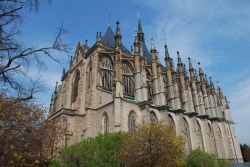 Kutna Hora was a prosperous Medieval town due to its silver mines. Now it still is prosperous due to tourism. The historic center is a 2.5 km walk from the train station past panalaks and rather uninteresting new buildings, with the exception of 2 structures, the Church of the Assumption of Our Lady, a baroque reconstruction of the original Medieval cathedral, and the extremely strange Ossuary of Sedlec. The exterior of the Ossuary is a fairly typical looking chapel. However, the basement is decorated with garlands, a chandelier, pyramids, crosses, chalices and even a coat of arms, all made up entirely of bones.
Kutna Hora was a prosperous Medieval town due to its silver mines. Now it still is prosperous due to tourism. The historic center is a 2.5 km walk from the train station past panalaks and rather uninteresting new buildings, with the exception of 2 structures, the Church of the Assumption of Our Lady, a baroque reconstruction of the original Medieval cathedral, and the extremely strange Ossuary of Sedlec. The exterior of the Ossuary is a fairly typical looking chapel. However, the basement is decorated with garlands, a chandelier, pyramids, crosses, chalices and even a coat of arms, all made up entirely of bones. 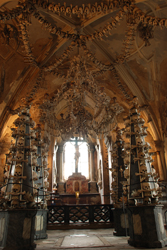
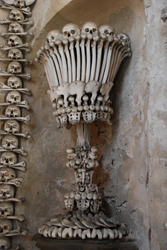
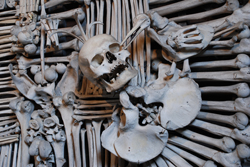
Like other cathedrals the temperature is cooler than the outside air which is warmed by the spring sun. One is immediately faced with the whimsical bone art: The garlands with leg or arm bones hanging like beads from a necklace, flowers or stars made from pelvic bones and sternums, and all manner of creative bone combinations. The majority of the bones (and it is estimated the art is made up of the bones of 40,000 people) make up 4 large pyramids in the corners made from alternating layers of skulls and leg bones. A giant gold crown is suspended above each. There were lots of coins sprinkled about the bone pyramids and I suspect people were trying to toss them into the eye sockets of the skulls, a strange combination of religious prayer offerings and carnival game.
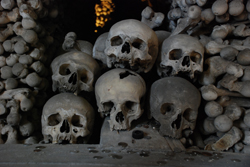
The most elegant piece is a chandelier with "chains" made of jaw bones, arm/leg bone "beads" and skulls for candle holders. The odd thing is instead of looking frightening, the whole arrangement has an odd cheerfulness to it, like party or wedding decorations (Corpse Bride?).
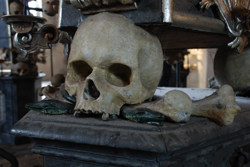
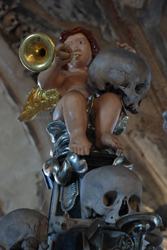
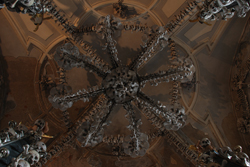
Of course, the big question is probably, "why?" According to an info sheet from the Ossuary, in the 13th century, the abbot of Sedlec went to Jerusalem and returned with a handful of dirt from Golgotha, which he sprinkled over the cemetery. This made it a fashionable place to be buried. In the 14th and 15th centuries, plagues and war brought more dead. Later the cemetery was made smaller. A half blinded monk stacked the bones inside the chapel. In the 18th century, the chapel was rebuilt in the Baroque style and the architect, for some reason, decided that bone decorations were the way to go. Later more decorations, including the coat of arms of the Schwartzburgs (including a rook picking at the eye of a Turk), were added by a carpenter.
From the ossuary, we walked into the historic center of town and headed straight to the Dacicky Pivnice on the recommendation of Denisa and Pavel. It is on Rakova 8, should you ever be in Kutna Hora. This was a very nicely decorated traditional Czech pub/restaurant. The clean light wood interior had numerous woodcut style pictures of dragons, whales, and other scenes. It was definitely touristicized (but in a good way-- the large dining area was non-smoking!). They played good traditional (medieval style) sounding music. In a medieval mood, I chose the wild boar goulash (with cranberries and gingerbread dumplings) while Rowshan had beef goulash with more traditional dumplings. The food was amazing and the staff were friendly. When I asked about the music playing, the waiter said to wait and he'd write down the names of some of the songs. He returned later with a CD of the music I liked which he gave us as a gift. We succumbed to dessert-- hot apple strudel with ice cream-- which we had to consume quickly because the room was filled by a tour group of Russian students.Stuffed and satisfied, we walked to St. Barbara's Cathedral, passing a pretty Gothic water tower on the way.
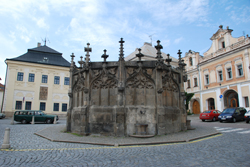
The cathedral was started in the 14th century but, due to interruptions of one sort or another, the work wasn't finished until 1905. Due to this, it has an interesting blend of Gothic structure and frescoes, Baroque decorations (altars, paintings), and Art Nouveau stained glass.
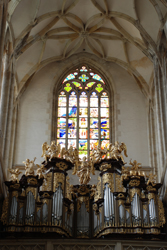
From the outside, it has a strange roof, almost like a circus tent, swooping up to the towers connecting to Gothic structure with the buttresses like leaf tendrils growing off the side of a solid, tan stone building.
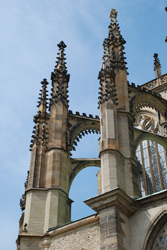
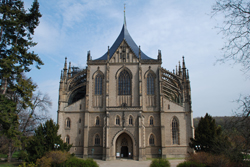
The sides have lots of glass making the stone between seem almost lace like. Long horizontal gargoyles jut from the building.
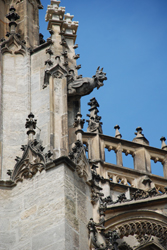
The inside is light filled.
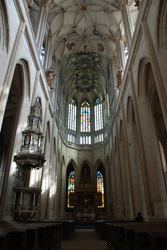
I found the medieval frescoes more humble and prettier than the Baroque pomp.
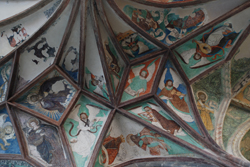
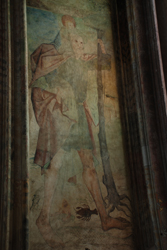
One interesting feature of the cathedral is the miners' chapel--which has frescoes of miner-- and the minters chapel with frescoes of coin makers.
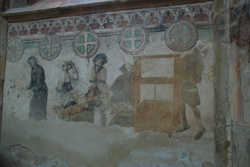
St. Barbara was the patron saint of miners. The cathedral reminded us of how, like Potosi, Kutna Hora was a miners' town. Unlike Potosi, however, the wealth stayed in the town making it prosperous instead of being shipped off to Spain.
We spent the rest of our time enjoying the spring day and the peaceful streets. St. Barbara is perched on a hill overlooking a valley full of trees, whose yellow green new leaves were bursting from the gray gnarled branches. The songs of the birds were so varied it was almost cacophonous.
[ View 1 Comments
|
]
Comments
esther ong -
posted on 6/15/2008
Both of you have a wealth of knowledge! History!
Powered by My Blog 1.69. Copyright 2003-2006 FuzzyMonkey.net.
Created by the scripting wizards at FuzzyMonkey.net..
(Code modified by Rowshan Dowlatabadi)
Created by the scripting wizards at FuzzyMonkey.net..
(Code modified by Rowshan Dowlatabadi)

